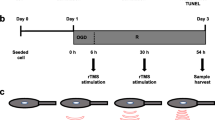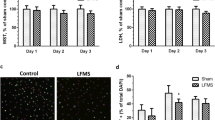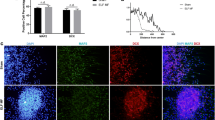Abstract
Astrocytes play an important role in the central nervous system function and may contribute to brain plasticity response during static magnetic fields (SMF) brain therapy. However, most studies evaluate SMF stimulation in brain plasticity while few studies evaluate the consequences of SMF at the cellular level. Thus, we here evaluate the effects of SMF at 305 mT (medium-intensity) in a primary culture of healthy/normal cortical astrocytes obtained from neonatal (1 to 2-day-old) Wistar rats. After reaching confluence, cells were daily subjected to SMF stimulation for 5 min, 15 min, 30 min, and 40 min during 7 consecutive days. Oxidative stress parameters, cell cycle, cell viability, and mitochondrial function were analyzed. The antioxidant capacity was reduced in groups stimulated for 5 and 40 min. Although no difference was observed in the enzymatic activity of superoxide dismutase and catalase or the total thiol content, lipid peroxidation was increased in all stimulated groups. The cell cycle was changed after 40 min of SMF stimulation while 15, 30, and 40 min led cells to death by necrosis. Mitochondrial function was reduced after SMF stimulation, although imaging analysis did not reveal substantial changes in the mitochondrial network. Results mainly revealed that SMF compromised healthy astrocytes’ oxidative status and viability. This finding reveals how important is to understand the SMF stimulation at the cellular level since this therapeutic approach has been largely used against neurological and psychiatric diseases.






Similar content being viewed by others
Abbreviations
- CNS:
-
central nervous system
- CONCEA:
-
National Council for Control of Animal Experimentation
- DMSO:
-
dimethylsulfoxide
- MF:
-
magnetic fields
- MTG:
-
MitoTracker Green
- MTR:
-
MitoTracker Red
- NeFeB:
-
neodymium-iron-boron
- SMF:
-
static magnetic field
- SMS:
-
static magnetic stimulation
References
Fregni, F., Boggio, P. S., & Brunoni, A. (2012). Neuromodulação Terapêutica: Princípios e Avanços da Estimulação Cerebral Não Invasiva em Neurologia, Reabilitação, Psiquiatria e Neuropsicologia. (F. Fregni, P. S. Boggio & A. R. Brunoni, Eds.) (primeira.). São Paulo: Sarvier.
Zorzo, C., Higarza, S. G., Méndez, M., Martínez, J. A., Pernía, A. M., & Arias, J. L. (2019). High frequency repetitive transcranial magnetic stimulation improves neuronal activity without affecting astrocytes and microglia density. Brain Research Bulletin, 150, 13–20. https://doi.org/10.1016/j.brainresbull.2019.05.004.
Oliviero, A., Mordillo-Mateos, L., Arias, P., Panyavin, I., Foffani, G., & Aguilar, J. (2011). Transcranial static magnetic field stimulation of the human motor cortex. Journal of Physiology, 589(20), 4949–4958. https://doi.org/10.1113/jphysiol.2011.211953.
Kufner, M., Brückner, S., & Kammer, T. (2017). No modulatory effects by transcranial static magnetic field stimulation of human motor and somatosensory cortex. Brain Stimulation, 10(3), 703–710. https://doi.org/10.1016/j.brs.2017.03.001.
Loo, C. K., McFarquhar, T. F., & Mitchell, P. B. (2008). A review of the safety of repetitive transcranial magnetic stimulation as a clinical treatment for depression. International Journal of Neuropsychopharmacology, 11(1), 131–147. https://doi.org/10.1017/S1461145707007717.
Ridding, M. C., & Rothwell, J. C. (2007). Is there a future for therapeutic use of transcranial magnetic stimulation? Nat Rev Neurosci, 8(7), 559–567. https://doi.org/10.1038/nrn2169.
Stock, M., Kirchner, B., Waibler, D., Cowley, D. E., Pfaffl, M. W., & Kuehn, R. (2012). Effect of magnetic stimulation on the gene expression profile of in vitro cultured neural cells. Neurosci Lett, 526(2), 122–127. https://doi.org/10.1016/j.neulet.2012.08.024.
Peterchev, A. V., Wagner, T. A., Miranda, P. C., Nitsche, M. A., Paulus, W., Lisanby, S. H., & Bikson, M. (2012). Fundamentals of transcranial electric and magnetic stimulation dose: Definition, selection, and reporting practices. Brain Stimulation, 5(4), 435–453. https://doi.org/10.1016/j.brs.2011.10.001.
Lozano-Soto, E., Soto-León, V., Sabbarese, S., Ruiz-Alvarez, L., Sanchez-del-Rio, M., Aguilar, J., & Oliviero, A. (2018). Transcranial static magnetic field stimulation (tSMS) of the visual cortex decreases experimental photophobia. Cephalalgia, 38(8), 1493–1497. https://doi.org/10.1177/0333102417736899.
Bodega, G., Forcada, I., Suárez, I., & Fernández, B. (2005). Acute and chronic effects of exposure to a 1-mT magnetic field on the cytoskeleton, stress proteins, and proliferation of astroglial cells in culture. Environmental Research, 98(3), 355–362. https://doi.org/10.1016/j.envres.2004.12.010.
Cullen, C. L., & Young, K. M. (2016). How does transcranial magnetic stimulation influence glial cells in the central nervous system? Frontiers in Neural Circuits, 10, 1–10. https://doi.org/10.3389/fncir.2016.00026.
Cappon, D., Jahanshahi, M., & Bisiacchi, P. (2016). Value and efficacy of transcranial direct current stimulation in the cognitive rehabilitation: a critical review since 2000. Frontiers in Neuroscience, 10. https://doi.org/10.3389/fnins.2016.00157.
Im, S. H., Yu, J. H., Park, E. S., Lee, J. E., Kim, H. O., Park, K. I., & Cho, S. R. (2010). Induction of striatal neurogenesis enhances functional recovery in an adult animal model of neonatal hypoxic-ischemic brain injury. Neuroscience, 169(1), 259–268. https://doi.org/10.1016/j.neuroscience.2010.04.038.
Kamida, T., Kong, S., Eshima, N., Abe, T., Fujiki, M., & Kobayashi, H. (2011). Transcranial direct current stimulation decreases convulsions and spatial memory deficits following pilocarpine-induced status epilepticus in immature rats. Behavioural Brain Research, 217(1), 99–103. https://doi.org/10.1016/j.bbr.2010.08.050.
Verkhratsky, A., Zorec, R., & Parpura, V. (2017). Stratification of astrocytes in healthy and diseased brain. Brain Pathology, 27(5), 629–644. https://doi.org/10.1111/bpa.12537.
Akdemir, E. S., Huang, A. Y., & Deneen, B. (2020). Astrocytogenesis: where, when, and how. F1000Res. 1-14. https://doi.org/10.12688/f1000research.22405.1.
Bramanti, V., Tomassoni, D., Avitabile, M., Amenta, F., & Avola, R. (2010). Biomarkers of glial cell proliferation and differentiation in culture. Front Biosci (Schol Ed). 2, 558–570. https://doi.org/10.2741/s85.
Clarke, D., Penrose, M. A., Penstone, T., Fuller-Carter, P. I., Hool, L. C., Harvey, A. R., & Bates, K. A. (2017). Frequency-specific effects of repetitive magnetic stimulation on primary astrocyte cultures. Restorative Neurology and Neuroscience, 35(6), 557–569. https://doi.org/10.3233/RNN-160708.
Khakh, B. S., & Sofroniew, M. V. (2015). Diversity of astrocyte functions and phenotypes in neural circuits. Nature Neuroscience, 18(7), 942–952. https://doi.org/10.1038/nn.4043.
Lange, S. C., Bak, L. K., Waagepetersen, H. S., Schousboe, A., & Norenberg, M. D. (2012). Primary cultures of astrocytes: their value in understanding astrocytes in health and disease. Neurochemical Research, 37(11), 2569–2588. https://doi.org/10.1007/s11064-012-0868-0.
Rodnight, R. B., & Gottfried, C. (2013). Morphological plasticity of rodent astroglia. Journal of Neurochemistry, 124(3), 263–275. https://doi.org/10.1111/jnc.12087.
Schildge, S., Bohrer, C., Beck, K., & Schachtrup, C. (2013). Isolation and Culture of Mouse Cortical Astrocytes. Journal of Visualized Experiments, 71, 1–7. https://doi.org/10.3791/50079.
Funchal, C., & Dani, C. (2014). Neurociências: Modelos experimentais em animais. Porto Alegre: Editora Universitária Metodista IPA: EDIPUCRS.
Medeiros, H. R., Assumpcao, J. A. F., Medeiros, L. F., Stapenhorst, M., Nunes, L., Henckes, N. A. C., & Torres, I. L. S. (2020). Static Magnetic Stimulation Induces Cell-type Specific Alterations in the Viability of SH-SY5Y Neuroblastoma Cell Line. Anticancer Research, 40(9), 5151–5158. https://doi.org/10.21873/anticanres.14518.
Cantello, R., Rossi, S., Varrasi, C., Ulivelli, M., Civardi, C., Bartalini, S., & Rossini, P. M. (2007). Slow repetitive TMS for drug-resistant epilepsy: Clinical and EEG findings of a placebo-controlled trial. Epilepsia, 48(2), 366–374. https://doi.org/10.1111/j.1528-1167.2006.00938.x.
Fregni, F., Boggio, P. S., Valle, A. C., Rocha, R. R., Duarte, J., Ferreira, M. J. L., & Pascual-Leone, A. (2006). A sham-controlled trial of a 5-day course of repetitive transcranial magnetic stimulation of the unaffected hemisphere in stroke patients. Stroke, 37(8), 2115–2122. https://doi.org/10.1161/01.STR.0000231390.58967.6b.
Fregni, F., Otachi, P. T. M., Do Valle, A., Boggio, P. S., Thut, G., Rigonatti, S. P., & Valente, K. D. (2006). A randomized clinical trial of repetitive transcranial magnetic stimulation in patients with refractory epilepsy. Annals of Neurology, 60(4), 447–455. https://doi.org/10.1002/ana.20950.
Joo, E. Y., Han, S. J., Chung, S. H., Cho, J. W., Seo, D. W., & Hong, S. B. (2007). Antiepileptic effects of low-frequency repetitive transcranial magnetic stimulation by different stimulation durations and locations. Clinical Neurophysiology, 118(3), 702–708. https://doi.org/10.1016/j.clinph.2006.11.008.
Galland, F., Seady, M., Taday, J., Smaili, S. S., Gonçalves, C. A., & Leite, M. C. (2019). Astrocyte culture models: Molecular and function characterization of primary culture, immortalized astrocytes and C6 glioma cells. Neurochemistry International, 131. https://doi.org/10.1016/j.neuint.2019.104538.
Lasič, E., Galland, F., Vardjan, N., Šribar, J., Križaj, I., Leite, M. C., Stenovec, M. (2016). Time-dependent uptake and trafficking of vesicles capturing extracellular S100B in cultured rat astrocytes. Journal of Neurochemistry, 309–323. https://doi.org/10.1111/jnc.13754.
Aebi, H. (1984). Catalase in vitro. Methods in Enzimology, 105, 121–126. https://doi.org/10.1016/S0076-6879(84)05016-3.
Misra, H. P., & Fridovich, I. (1972). The role of superoxide anion in the autoxidation of epinephrine and a simple assay for superoxide dismutase. Journal of Biological Chemistry, 247(10), 3170–3175.
Amado, L. L., Garcia, M. L., Ramos, P. B., Freitas, R. F., Zafalon, B., Ferreira, J. L. R., & Monserrat, J. M. (2009). A method to measure total antioxidant capacity against peroxyl radicals in aquatic organisms: application to evaluate microcystins toxicity. Science of the Total Environment, 407(6), 2115–2123. https://doi.org/10.1016/j.scitotenv.2008.11.038.
Aksenov, M. Y., & Markesbery, W. R. (2001). Changes in thiol content and expression of glutathione redox system genes in the hippocampus and cerebellum in Alzheimer’s disease. Neuroscience Letters, 302(2–3), 141–145. https://doi.org/10.1016/S0304-3940(01)01636-6.
Federici, G., Shaw, B. J., & Handy, R. D. (2007). Toxicity of titanium dioxide nanoparticles to rainbow trout (Oncorhynchus mykiss): Gill injury, oxidative stress, and other physiological effects. Aquatic Toxicology, 84(4), 415–430. https://doi.org/10.1016/j.aquatox.2007.07.009.
Steckler, D., Stout, T. A. E., Durandt, C., & Nöthling, J. O. (2015). Validation of merocyanine 540 staining as a technique for assessing capacitation-related membrane destabilization of fresh dog sperm. Theriogenology, 83(9), 1451–1460. https://doi.org/10.1016/j.theriogenology.2015.01.019.
Pedra, N. S., De Cássia Araújo Galdino, K., Da Silva, D. S., Ramos, P. T., Bona, N. P., Soares, M. S. P., & Braganhol, E. (2018). Endophytic fungus isolated from achyrocline satureioides exhibits selective antiglioma activity-the role of sch-642305. Frontiers in Oncology, 8, 1–20. https://doi.org/10.3389/fonc.2018.00476.
Viau, C. M., Moura, D. J., Facundo, V. A., & Saffi, J. (2014). The natural triterpene 3β,6β,16β-trihydroxy-lup-20(29)-ene obtained from the flowers of Combretum leprosum induces apoptosis in MCF-7 breast cancer cells. BMC Complementary and Alternative Medicine, 14(1), 1–12. https://doi.org/10.1186/1472-6882-14-280.
Valiron, O., Peris, L., Rikken, G., Schweitzer, A., Saoudi, Y., Remy, C., & Job, D. (2005). Cellular disorders induced by high magnetic fields. Journal of Magnetic Resonance Imaging, 22(3), 334–340. https://doi.org/10.1002/jmri.20398.
Meira Martins, L. A., Vieira, M. Q., Ilha, M., de Vasconcelos, M., Biehl, H. B., Lima, D. B., & Guma, F. C. R. (2015). The interplay between apoptosis, mitophagy and mitochondrial biogenesis induced by resveratrol can determine activated hepatic stellate cells death or survival. Cell Biochemistry and Biophysics, 71(2), 657–672. https://doi.org/10.1007/s12013-014-0245-5.
Agnello, M., Morici, G., & Rinaldi, A. M. (2008). A method for measuring mitochondrial mass and activity. Cytotechnology, 56(3), 145–149. https://doi.org/10.1007/s10616-008-9143-2.
Peterson, G. L. (1979). Review of the folin phenol protein quantitation method of lowry, rosebrough, farr and randall. Analytical Biochemistry, 100(2), 201–220. https://doi.org/10.1016/0003-2697(79)90222-7.
Bayraktar, O. A., Fuentealba, L. C., Alvarez-Buylla, A., & Rowitch, D. H. (2015). Astrocyte development and heterogeneity. Cold Spring Harbor Perspectives in Biology, 7(1). https://doi.org/10.1101/cshperspect.a020362.
Colbert, A. P., Souder, J., & Markov, M. (2009). Static magnetic field therapy: Methodological challenges to conducting clinical trials. Environmentalist, 29(2 SPEC. ISS.), 177–185. https://doi.org/10.1007/s10669-008-9203-3.
Ghodbane, S., Ammari, M., Lahbib, A., Sakly, M., & Abdelmelek, H. (2015). Static magnetic field exposure–induced oxidative response and caspase-independent apoptosis in rat liver: effect of selenium and vitamin E supplementations. Environmental Science and Pollution Research, 22(20), 16060–16066. https://doi.org/10.1007/s11356-015-4802-2.
Dinčić, M., Krstić, D. Z., Čolović, M. B., Nešović Ostojić, J., Kovačević, S., De Luka, S. R., & Todorović, J. (2018). Modulation of rat synaptosomal ATPases and acetylcholinesterase activities induced by chronic exposure to the static magnetic field. International Journal of Radiation Biology, 94(11), 1062–1071. https://doi.org/10.1080/09553002.2018.1518611.
Bolaños, J. P. (2016). Bioenergetics and redox adaptations of astrocytes to neuronal activity. Journal of Neurochemistry, 139, 115–125. https://doi.org/10.1111/jnc.13486.
McBean, G. J. (2017). Cysteine, glutathione, and thiol redox balance in astrocytes. Antioxidants, 6(3), 1–13. https://doi.org/10.3390/antiox6030062.
Mohammadi, F., Ghanati, F., Sharifi, M. & Chashmi, NA. (2018). Oÿn the mechanism of the cell cycle control of suspension-cultured tobacco cells after exposure to static magnetic field. Plant Science, 277, 139–144. https://doi.org/10.1016/j.plantsci.2018.08.004.
Sadri, M., Abdolmaleki, P., Abrun, S., Beiki, B., & Samani, F. S. (2017). Static Magnetic Field Effect on Cell Alignment, Growth, and Differentiation in Human Cord-Derived Mesenchymal Stem Cells. Cellular and Molecular Bioengineering, 10(3), 249–262. https://doi.org/10.1007/s12195-017-0482-y.
Nakamichi, N., Ishioka, Y., Hirai, T., Ozawa, S., Tachibana, M., Nakamura, N., & Yoneda, Y. (2009). Possible promotion of neuronal differentiation in fetal rat brain neural progenitor cells after sustained exposure to static magnetism. Journal of Neuroscience Research, 87(11), 2406–2417. https://doi.org/10.1002/jnr.22087.
Buemi, M., Di, G., & Floccari, F. (2001). Cell proliferation/cell death balance in renal cell cultures after exposure to a static magnetic field. Nephron, 87, 269–273. https://doi.org/10.1159/000045925.
Calabrò, E., Magazù, S., Currò, M., & Ientile, R. (2020). The inverse relation between mitochondrial transmembrane potential and proteins α-helix in neuronal-like cells under static magnetic field and the role of VDAC. Electromagnetic Biology and Medicine, 8378. https://doi.org/10.1080/15368378.2020.1737808.
Bulthuis, E. P., Adjobo-Hermans, M. J. W., Willems, P. H. G. M., & Koopman, W. J. H. (2019). Mitochondrial Morphofunction in Mammalian Cells. Antioxidants and Redox Signaling (Vol. 30). https://doi.org/10.1089/ars.2018.7534.
Meyer, J. N., Leuthner, T. C. & & Luz, A. L. (2017). Mitochondrial fusion, fission, and mitochondrial toxicity Submitted for consideration for the Special Issue of Toxicology on “Chemical Mitochondrial Toxicity. Toxicology, 1, 100–106. https://doi.org/10.1016/j.gde.2016.03.011.
Verkhratsky, A., & Nedergaard, M. (2018). Physiology of astroglia. Physiological Reviews, 98(1), 239–389. https://doi.org/10.1152/physrev.00042.2016.
Acknowledgements
We are grateful to Biotério Central da Universidade Federal de Pelotas (UFPel), to Laboratório de Virologia e Imunologia da UFPel (LabVir), to Laboratório de Bioquímica da Universidade Federal do Rio Grande do Sul, to Conselho Nacional de Desenvolvimento Científico e Tecnológico- Brasil (CNPq), and to HCPA Biomedical Engineering Laboratory.
Funding
This study was financed in part by Conselho Nacional de Desenvolvimento Científico e Tecnológico- Brasil (CNPq) (edital MCTI/CNPQ/UNIVERSAL 14/2014) and HCPA Biomedical Engineering Laboratory (MCT/Finep/COENG).
Author information
Authors and Affiliations
Corresponding author
Ethics declarations
Competing Interests
The authors declare no competing interests.
Ethics approval
Experimental procedures were approved by the Committee on Ethics and Animal Experimentation of the Federal University of Pelotas, Brazil (protocol number CEEA 4408-2016), and the use of animals was in accordance with the Brazilian Guidelines for the Care and Use of Animals in Scientific Research Activities (DBCA), the National Council for Control of Animal Experimentation (CONCEA) and the National Institutes of Health Guide for the Care and Use of Laboratory Animals (NIH Publications No. 8023, revised 1978).
Additional information
Publisher’s note Springer Nature remains neutral with regard to jurisdictional claims in published maps and institutional affiliations.
Rights and permissions
About this article
Cite this article
da Costa, C.C., Martins, L.A.M., Koth, A.P. et al. Static Magnetic Stimulation Induces Changes in the Oxidative Status and Cell Viability Parameters in a Primary Culture Model of Astrocytes. Cell Biochem Biophys 79, 873–885 (2021). https://doi.org/10.1007/s12013-021-01015-7
Accepted:
Published:
Issue Date:
DOI: https://doi.org/10.1007/s12013-021-01015-7




